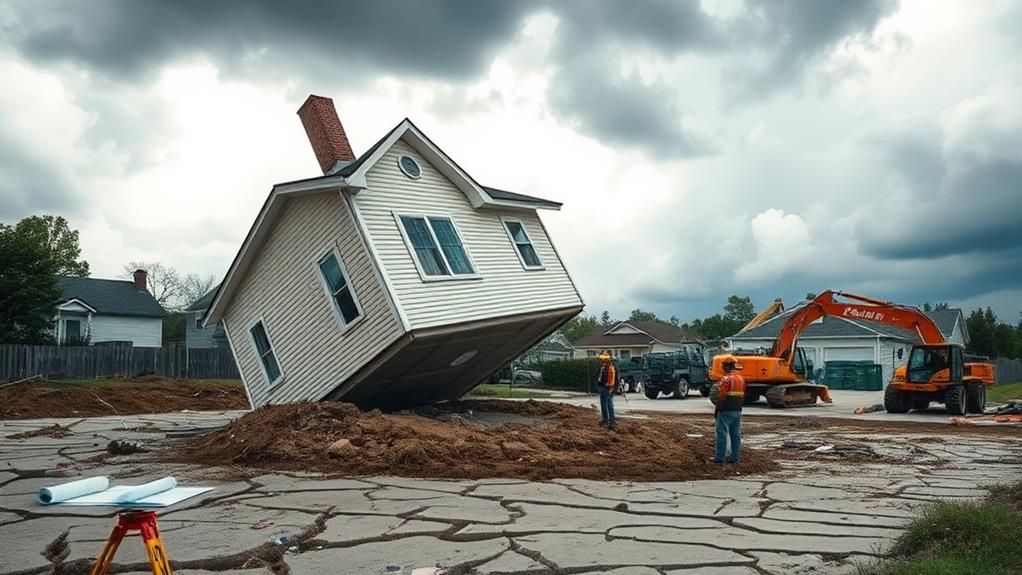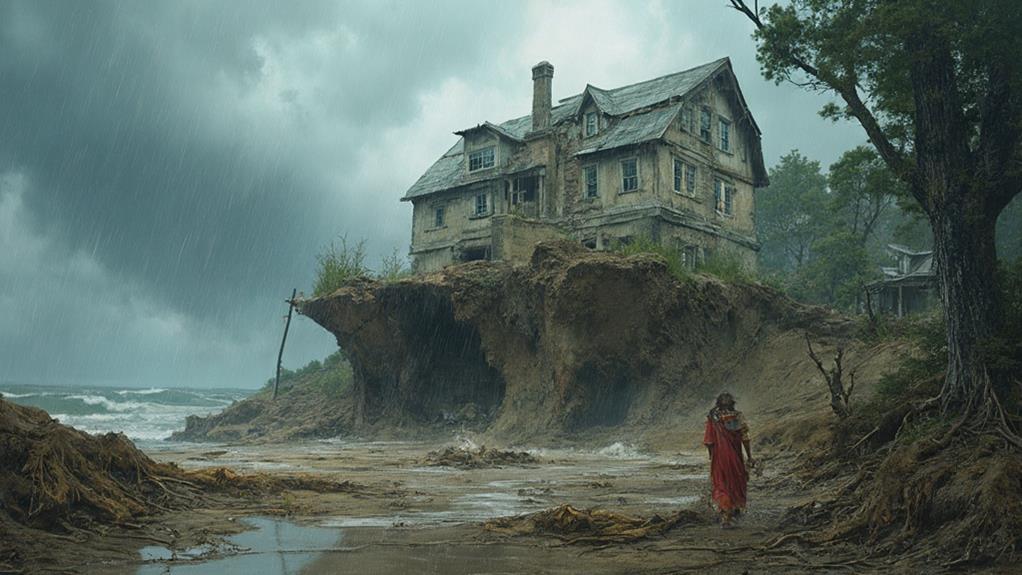Storm-induced foundation problems can arise from various factors, including soil erosion, expansion, and hydrostatic pressure. Common warning signs include visible cracks, sticking doors and windows, and uneven floors. The soil composition plays a crucial role in how storms impact foundations, with clay-rich and sandy soils being particularly vulnerable. Homeowners can take preventive measures like ensuring proper drainage and regular inspections. For severe issues, professional assessment and repair options such as underpinning or hydraulic lifting may be necessary. Understanding these factors and taking proactive steps can help protect your home's structural integrity and maintain its value. Exploring further will reveal additional insights into safeguarding your property against storm-related foundation damage.
Types of Storm-Induced Foundation Issues

Storms can wreak havoc on a home's foundation, causing a variety of issues that compromise structural integrity. Heavy rainfall and flooding can lead to soil erosion, undermining the foundation's stability.
As water saturates the ground, it can cause soil expansion, exerting pressure on foundation walls and potentially leading to cracks or bowing.
Another common issue is settlement, where saturated soil compresses under the weight of the structure, causing the foundation to sink unevenly. This can result in tilting walls, uneven floors, and gaps around windows and doors. In extreme cases, storms may trigger landslides or mudslides, which can severely damage or completely destroy a home's foundation.
Hydrostatic pressure from rising groundwater levels can force water through small cracks in the foundation, leading to basement flooding and potential long-term moisture problems. Additionally, strong winds during storms can uproot trees, whose root systems may damage nearby foundations as they fall or are removed.
Frost heave is another concern in colder climates, where storm-induced moisture freezes and expands in the soil, pushing against the foundation and causing uplift or cracking.
Warning Signs of Foundation Damage
Recognizing the warning signs of foundation damage is key to addressing problems before they escalate. Homeowners should be vigilant for visible cracks in walls, floors, or ceilings, especially if they appear suddenly after a storm. These cracks may be diagonal, vertical, or horizontal, and can vary in width. Doors and windows that stick or no longer close properly can indicate foundation shifting. Uneven or sloping floors are another telltale sign, as is the separation of walls from ceilings or floors.
Exterior signs include cracks in brick or stonework, particularly those that form a stair-step pattern. Gaps between exterior walls and windows or doors may also appear. Foundation walls that bow or lean suggest serious structural issues. Water pooling near the foundation after rain can indicate improper drainage, potentially leading to foundation problems. Homeowners should also watch for soil pulling away from the foundation or unusually damp crawl spaces. In severe cases, visible sinking of one part of the house may occur. If any of these signs are observed, especially following a major storm, it's crucial to consult a professional foundation expert promptly.
Soil Composition and Storm Impact

Invariably, the composition of soil plays a crucial role in how a foundation responds to storm-induced stress. Different soil types react uniquely to excessive moisture, which can significantly impact the stability of a structure's foundation. Clay-rich soils, for instance, are prone to expansion when saturated, exerting pressure on foundation walls and potentially causing cracks or shifts. Conversely, sandy soils may become unstable and prone to erosion, leading to settlement issues.
During storms, the rapid influx of water can overwhelm the soil's natural drainage capacity, particularly in areas with poor grading or inadequate drainage systems. This oversaturation can weaken the soil structure, reducing its load-bearing capacity and compromising the foundation's integrity. Additionally, prolonged exposure to moisture can lead to soil consolidation, where the soil particles become more tightly packed, potentially causing uneven settlement.
Understanding the local soil composition is crucial for implementing appropriate preventive measures. Proper landscaping, installation of efficient drainage systems, and regular maintenance can mitigate the impact of storms on foundations. In areas prone to severe weather, specialized foundation designs may be necessary to account for soil-specific challenges and ensure long-term structural stability.
Preventive Measures for Homeowners
With an understanding of how soil composition and storms affect foundations, homeowners can take proactive steps to protect their property. Regular maintenance is crucial in preventing storm-induced foundation problems.
Ensure proper drainage around the house by grading the soil away from the foundation and installing gutters and downspouts that direct water at least 5 feet from the structure.
Inspect the foundation periodically for cracks or signs of settling, addressing any issues promptly. Consider installing a French drain system to divert excess water away from the foundation. In areas prone to severe storms, reinforce the foundation with steel or carbon fiber supports.
Maintain consistent soil moisture levels around the foundation by watering during dry periods and using soaker hoses. This helps prevent soil shrinkage and expansion. Plant vegetation with shallow root systems near the house to stabilize the soil without causing damage to the foundation.
For homes in high-risk areas, consult a structural engineer to assess the property's vulnerability and recommend specific reinforcement measures. Finally, ensure your homeowner's insurance policy covers foundation damage caused by storms, as many standard policies exclude this type of coverage.
Professional Assessment and Repair Options

When should homeowners seek professional help for storm-induced foundation problems? Any signs of foundation damage, such as cracks in walls, uneven floors, or doors that no longer close properly, warrant a professional assessment. Experts recommend contacting a structural engineer or licensed foundation contractor for a thorough evaluation.
During the assessment, professionals will inspect the foundation's exterior and interior, looking for signs of settling, shifting, or water damage. They may use specialized tools like laser levels and moisture meters to gather precise data. Based on their findings, they'll provide a detailed report outlining the extent of the damage and recommended repair options.
Common repair methods include foundation underpinning, which involves installing support piers to stabilize the foundation, and hydraulic lifting to correct uneven settling. For water-related issues, professionals may recommend installing or repairing drainage systems, waterproofing the foundation, or addressing soil erosion around the property. The cost and complexity of repairs can vary significantly, depending on the severity of the damage and the chosen repair method. It's advisable to obtain multiple assessments and quotes before proceeding with any major foundation work.
Long-Term Effects on Property Value
Storm-induced foundation problems can cast a long shadow over a property's market value. These issues, if left unaddressed, can significantly diminish a home's worth and attractiveness to potential buyers. Even after repairs, the property may still face stigma in the real estate market, as prospective purchasers often view past foundation issues with skepticism.
The impact on property value depends on several factors, including the severity of the damage, quality of repairs, and local market conditions. In some cases, a well-documented repair history can actually be a selling point, demonstrating the home's resilience and updated foundation. However, in many instances, properties with a history of foundation problems sell for 10-20% less than comparable homes without such issues.
Long-term effects may include increased insurance premiums, difficulty obtaining mortgages, and potential disclosure requirements during future sales. To mitigate these impacts, homeowners should maintain detailed records of all assessments, repairs, and ongoing maintenance. Regular inspections and proactive measures to prevent future damage can help restore confidence in the property's structural integrity and preserve its value over time.
Frequently Asked Questions
How Long Does It Take for Storm-Induced Foundation Damage to Become Noticeable?
Storm-induced foundation damage can become noticeable within days or weeks, depending on severity. However, some issues may take months or even years to manifest visibly. Regular inspections are crucial to detect early signs of damage.
Can Homeowners Insurance Cover Storm-Related Foundation Repairs?
Ah, the irony of nature's wrath—shaking our very foundations! Homeowners insurance typically covers sudden, accidental storm damage to foundations. However, gradual damage or pre-existing issues are often excluded. Review your policy carefully and consider additional coverage options.
Are Certain House Designs More Susceptible to Storm-Induced Foundation Problems?
Certain house designs are indeed more susceptible to storm-induced foundation problems. Structures with inadequate drainage, shallow foundations, or those built on expansive soils are particularly vulnerable. Elevated homes and those with proper water management systems generally fare better.
How Often Should Foundations Be Inspected in Storm-Prone Areas?
An ounce of prevention is worth a pound of cure. In storm-prone areas, foundations should be inspected annually, ideally before storm season. More frequent inspections may be necessary after severe weather events or if signs of damage appear.
Can Foundation Issues Caused by Storms Lead to Mold or Pest Infestations?
Foundation issues caused by storms can indeed lead to mold and pest infestations. Cracks and gaps allow moisture intrusion, creating ideal conditions for mold growth. These openings also provide entry points for pests seeking shelter and moisture.
Conclusion
Storm-induced foundation problems pose significant risks to structural integrity and property values. Recent research suggests that climate change may exacerbate these issues, with more frequent extreme weather events potentially leading to increased foundation damage. Homeowners must remain vigilant, recognizing warning signs and implementing preventive measures. Professional assessments and timely repairs are crucial for mitigating long-term effects. As environmental conditions evolve, further studies on soil behavior and foundation resilience will be essential for developing more effective protection strategies and building codes.

